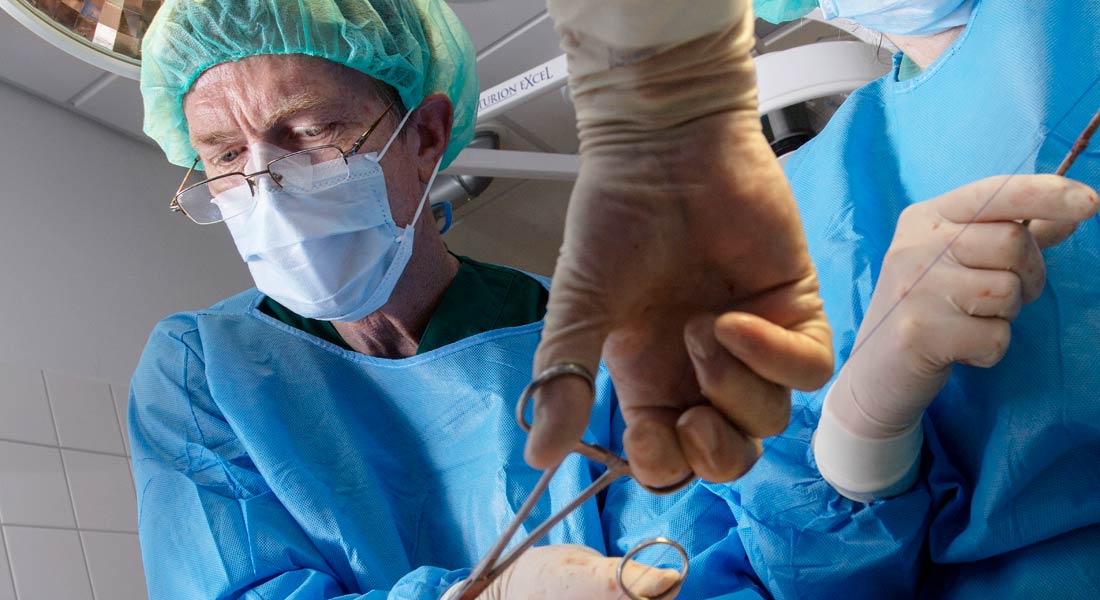Companion Animal Surgery – Orthopaedics II - Large Joint Surgery
This course is a compulsory course at the Master of Companion Animal Clinical Science. The Master is a postgraduate education targeting small animal veterinarians seeking Continual Professional Development (CPD).
The purpose of this course is to extend the student’s knowledge, skills, and competences in the approach to, assessment, diagnosis, and management of the sick companion animal patient in need of large joint orthopaedic surgery.
The course will extend the students assessment and management of the companion animal patient in need of large joint orthopaedic surgery and plan the perioperative management of the patient, including specific anaesthesia and analgesia requirements.
Read more about the Master of Companion Animal Clinical Science.
A mixture of case-based and problem oriented lectures, e-learning, theoretical and practical exercises. Case-study work. Scientific literature.
Having completed the course, the student must be able to:
Knowledge
- Understand the aetiology, pathophysiology and clinical appearance of surgical disorders of the large joints.
- Understand the influence of surgical disorders of the large joints of the musculoskeletal system on the selection of anaesthesia and anagelsia protocols.
- Use and continue to develop common and typical techniques in musculoskeletal disease focused on large joint disorders.
- Explain, reflect about, and discuss a problem oriented and evidence based work-up and treatment plan for patients with large joint disorders.
- Define and identify relevant anatomical structures
Skills
- Perform advanced atraumatic surgical techniques in particular with regards to tissue handling and minimal invasive diagnostics in regard to disorders of the large joints including;
- Shoulder disorders e.g. biceps tenosynovitis, medial instability
- Elbow disorders e.g. ununited anconeal process, medial coronoid disease
- Hip joint disorders e.g. femoral head and neck excision, stabilization techniques for luxation.
- Stifle joint and patellar disorders including meniscectomy, arthrotomy, extracapsular stabilization, trochlear recession, tibial tuberosity transposition and lateral imbrication.
- Risk assessment after surgery with focus on treatment effect, complications and estimation of prognosis.
Competences
- Evaluate, plan and manage a diagnostic work-up for a patient with a complex history within companion animal large joint disorders.
- Plan advanced therapy/procedures for companion animal orthopaedic large joint surgery patients.
- Independently obtain, evaluate and elaborate on evidence-based new knowledge within companion animal large joint orthopaedic surgery.
- Collaborate and communicate within and between specialist and non-specialist peers and laypersons involved in companion animal large joint orthopaedic surgical patient management.
You must meet the following criteria to be admitted to this course:
- Hold a degree in Veterinary Medicine
- Have a minimum of 2 years of relevant job experience from companion animal practice
- Be proficient in English
- Have completed the previous courses at the Companion Animal Surgery track.
Please consult the formal requirements for this course.
The course responsibles at the compulsory course in Companion Animal Surgery are:
- Professor James Edward Miles, Department of Veterinary Clinical Sciences, The Faculty of Health and Medical Sciences, University of Copenhagen, Denmark.
- Research consultant Dorthe Hansen, Department of Veterinary Clinical Sciences, The Faculty of Health and Medical Sciences, University of Copenhagen, Denmark.
Lecturers at the compulsory course are:
- Professor James Edward Miles, Department of Veterinary Clinical Sciences, The Faculty of Health and Medical Sciences, University of Copenhagen, Denmark.
- Research consultant Dorthe Hansen, Department of Veterinary Clinical Sciences, The Faculty of Health and Medical Sciences, University of Copenhagen, Denmark.
- Other national and international capacities within the field.
Course details
| Duration: | 5 days |
| Dates: | 4-8 September 2023 - class of 2022 12-16 May 2025 - class of 2024 |
| Frequency: | Only available every second year |
| Course capacity: | 24 students |
| Place: | Novara, Italy |
| Course fee: | EU/EEA citizens: 32,500 DKK Non-EU/EEA citizens: 36,033 DKK Tuition fees include hotel and full board. |
| Level and credit: | Master course; 5 ECTS |
| Examination date: | Please consult the exam schedule |
| Application deadline: | Master's programme: 1 May 2023 - class of 2024 |
| Admission: | Please consult the formal requirements for this course in the course curriculum |
The opening of the application period is announced via the programme newsletter.
Download course curriculum

